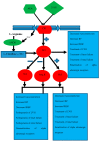Role of Nitric Oxide in the Cardiovascular and Renal Systems
- PMID: 30177600
- PMCID: PMC6164974
- DOI: 10.3390/ijms19092605
Role of Nitric Oxide in the Cardiovascular and Renal Systems
Abstract
The gasotransmitters are a family of gaseous signaling molecules which are produced endogenously and act at specific receptors to play imperative roles in physiologic and pathophysiologic processes. As a well-known gasotransmitter along with hydrogen sulfide and carbon monoxide, nitric oxide (NO) has earned repute as a potent vasodilator also known as endothelium-derived vasorelaxant factor (EDRF). NO has been studied in greater detail, from its synthesis and mechanism of action to its physiologic, pathologic, and pharmacologic roles in different disease states. Different animal models have been applied to investigate the beneficial effects of NO as an antihypertensive, renoprotective, and antihypertrophic agent. NO and its interaction with different systems like the renin⁻angiotensin system, sympathetic nervous system, and other gaseous transmitters like hydrogen sulfide are also well studied. However, links that appear to exist between the endocannabinoid (EC) and NO systems remain to be fully explored. Experimental approaches using modulators of its synthesis including substrate, donors, and inhibitors of the synthesis of NO will be useful for establishing the relationship between the NO and EC systems in the cardiovascular and renal systems. Being a potent vasodilator, NO may be unique among therapeutic options for management of hypertension and resulting renal disease and left ventricular hypertrophy. Inclusion of NO modulators in clinical practice may be useful not only as curatives for particular diseases but also for arresting disease prognoses through its interactions with other systems.
Keywords: angiotensin II; hypertension; kidney disease; nitric oxide; noradrenaline; vasodilation.
Conflict of interest statement
All authors declare no conflicts of interest.
Figures




References
Publication types
MeSH terms
Substances
Grants and funding
LinkOut - more resources
Full Text Sources
Other Literature Sources
Medical
Research Materials
Miscellaneous

